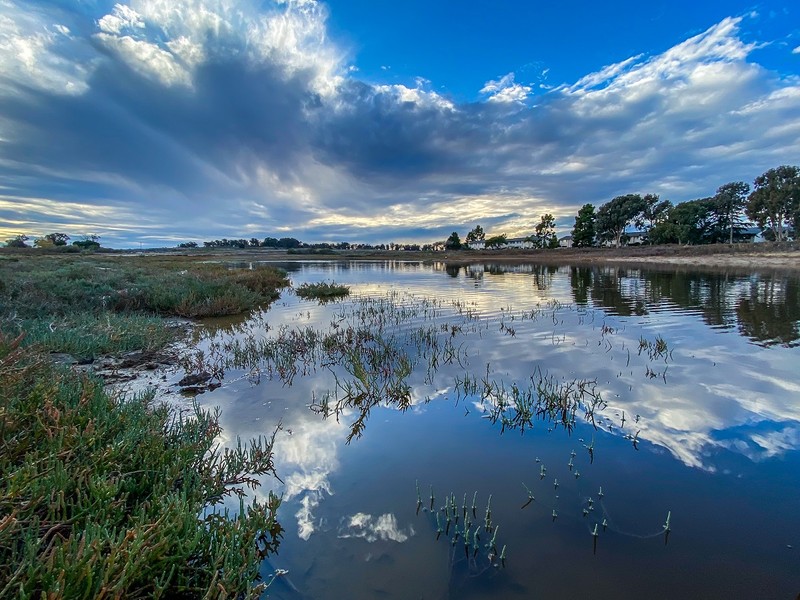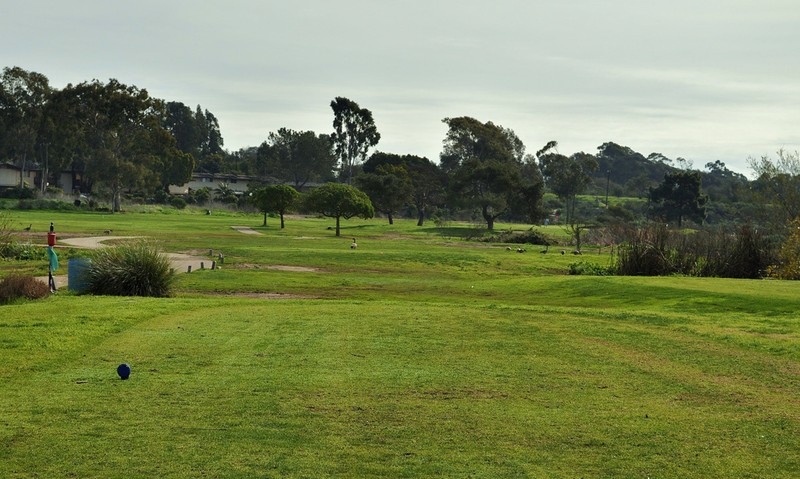The Former Ocean Meadows at NCOS
Introduction
Author-Uploaded Audio
Listen to a narration of this entry's description by Nicky Rehnberg.
Text-to-speech Audio
Recommended Time: 10 minutes
Keep walking towards Isla Vista and look out towards the ocean. What do you see? What does the landscape look like? Do you see any non-flora or non-fauna (e.g., environmental management equipment, garden stakes and hoses, rope, etc.)? How far can you look out? If it is a really clear day and you have good eyesight, you can see the ocean from this point.
How has this landscape changed?
What if I told you that a decade ago, this was a fully functional nine-hole golf course? I will tell you all about it in the next section.
Images
NCOS


Backstory and Context
Author-Uploaded Audio
Listen to a narration of this entry's description by Nicky Rehnberg.
Text-to-speech Audio
The first golf course on Ellwood Devereux opened in 1966. There were also some natural features to the land that made it less-than-ideal as a golf course. Remember the vernal pools from our first stop? There were some here at Ocean Meadows, too.
Civil engineers believed that there was a solution to this problem and that the golf course could live up to its name – Ocean Meadow – if they collected storm runoff and accepted annual flooding. They did this by filling the northern part of the Devereux Slough on the site with soil moved from the adjacent pieces of land, such as the North and South Parcel, which UCSB owned. Their plan kind of worked, but the golf course flooded excessively.
It was a neighborhood course, but as the years went on and other, larger courses opened in Santa Barbara county, the course became less successful.
We could say that golfing here was a swing and a miss.
In 1994, a new land developer wanted to build more houses on the golf course, but because of the flooding, they would have to be located on the higher ground of the property. While this plan was approved by the city, environmental activists, many who had already been involved with the fight of the 1980s and 1990s to save the coastal bluff, decided to return to fundraising and buy the Ocean Meadows land and try to reunite the larger ecosystem, now a patchwork of different conservation, preservation, and restoration projects from UCSB.
The debates on what to do with this land continued into the early twenty-first century.
Besides the work of environmental activists, another force made it possible to “save” Ocean Meadows: the Subprime Mortgage Crisis of 2007 to 2010. Property value kept falling but upkeep costs kept rising, and the Trust for Public Land (a different group than the Santa Barbara Land Trust) were able to fundraise $7.2 million to buy the land. To do this, Lisa Stratton from CCBER and other local environmentalists wrote many, many grant applications to secure the funds. The Trust would then give the land to UCSB as long as they followed the stipulations of how the land was to be used.
Do you think that everyone was excited about this project? Why or why not?
Golfers, especially ones who lived close by, were not thrilled. Others worried about the role that political lobbying played in the decision-making process and were not sure if this project was fair. Others still worried about neighborhood property values: would a public park diminish the value of their home, which – if they owned it – was a financial investment?
But UCSB researchers had done a lot of analysis on the area for decades. They knew the site inside and out, which made it easier to work with local, state, and federal agencies. Some of these included the Land Trust for Santa Barbara County, Santa Barbara County, State Coastal Conservancy, CalTrans, California Department of Water Resources, California Department of Fish and Wildlife, US Fish and Wildlife Service, and Ocean Protection Council. The first group to say that this area should be protected, several interviewers attested, was the Santa Barbara Audubon Society.
While not an insider transaction, the protection of this area did benefit from the great network of community and environmental research and legislative precedents that was also a part of this. The work of Wayne Ferren, Jr. and his decades of students who researched these lands and later went into public and private environmental practice in Santa Barbara county, Scott Cooper headed the campus NRS system, Cris Sandoval as director of Coal Oil Point Reserve, Dan Gira wrote the Administrative Draft Joint Proposal for Ellwood Devereux, Robert Silsbee worked at UCSB in housing, Duncan Mellichamp and Chancellor Henry Yang worked with the campus community, Bill Wallace served as Chair of the Board of Supervisors and worked with County Supervisor and Supervisor of the Third District Gail Marshall and convinced the university not to build houses on the bluffs, Carla Frisk who worked for Trust for Public Land and in the county office, who worked with Linda Krop as head legal counsel for the Environmental Defense Center, who worked with Debra Geiler and Suzanne Moss, and Lisa Stratton as Director of Ecosystem Management for the CCBER passionately led and wrote grants to protect the parcels of land now known as North Campus Open Space (NCOS).
The NCOS restoration project is located on three parcels, each owned by UCSB: the South Parcel (68.9 acres), Whittier Parcel (3.70 acres) and the former Ocean Meadows Golf Course (63.8 acres).. The NCOS restoration project encompasses 136.4 acres located at the downstream end of a 3.5-square mile watershed that includes Devereux Creek, Phelps Creek (also known as El Encanto Creek north of the project site) and several unnamed tributaries.
All of these different local, university, county, and state resources had to come together for decades to make sure that Ellwood Devereux could exist as an open space. As you walk around, do you think all of this work was worth it? What do you wish you could see more of in the landscape? What would you like to see less of? How do you think you can become involved in the home-making that we all do when we live, work, and play on and around Ellwood Devereux?
Exploration Questions
- Do you like or play golf? If so, you may have noticed that a lot of golf courses are located right on the coast (whether it be in California or Scotland, where the sport came from!). Why do you think that is the case? After all, as we discussed at the Sands Beach stop, there are many different kinds of recreation that do not require the amount of space and resources (e.g., water, grass, maintenance).
- Provide a plain-language definition of environmental restoration. What is it trying to accomplish and how, generally?
- Between conservation, preservation, and restoration – three very different projects, remember – how do you think Ellwood Devereux should be treated? Make sure to define your choice and explain your reasoning.
Sources
Author's interview with Wayne Ferren, Jr., Scott Cooper, Cris Sandoval, Dan Gira, Robert Silsbee, Duncan Mellichamp, Carla Frisk, Linda Krop, Debra Geiler, and Lisa Stratton, 2018-2021.
"North Campus Open Space." University of California, Santa Barbara: Cheadle Center for Biodiversity and Ecological Education. https://www.ccber.ucsb.edu/ecosystem/management-areas/north-campus-open-space
Olson, John. "A History of Ocean Meadows: Elbowing Goleta Aside" The Santa Barbara Independent; December 13, 2012. https://www.independent.com/2012/12/13/history-ocean-meadows/
https://www.ccber.ucsb.edu/ecosystem/management-areas/north-campus-open-space
